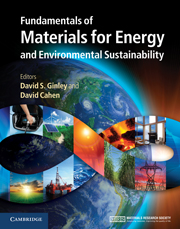Book contents
- Frontmatter
- Contents
- Contributors
- Preface
- Acknowledgments
- Part 1 Energy and the environment: the global landscape
- Part 2 Nonrenewable energy sources
- 9 Petroleum and natural gas
- 10 Advancing coal conversion technologies: materials challenges
- 11 Oil shale and tar sands
- 12 Unconventional energy sources: gas hydrates
- 13 Nuclear energy: current and future schemes
- 14 Nuclear non-proliferation
- 15 Nuclear-waste management and disposal
- 16 Material requirements for controlled nuclear fusion
- Part 3 Renewable energy sources
- Part 4 Transportation
- Part 5 Energy efficiency
- Part 6 Energy storage, high-penetration renewables, and grid stabilization
- Summary
- Appendix A Thermodynamics
- Appendix B Electrochemistry
- Appendix C Units
- Index
- References
13 - Nuclear energy: current and future schemes
from Part 2 - Nonrenewable energy sources
Published online by Cambridge University Press: 05 June 2012
- Frontmatter
- Contents
- Contributors
- Preface
- Acknowledgments
- Part 1 Energy and the environment: the global landscape
- Part 2 Nonrenewable energy sources
- 9 Petroleum and natural gas
- 10 Advancing coal conversion technologies: materials challenges
- 11 Oil shale and tar sands
- 12 Unconventional energy sources: gas hydrates
- 13 Nuclear energy: current and future schemes
- 14 Nuclear non-proliferation
- 15 Nuclear-waste management and disposal
- 16 Material requirements for controlled nuclear fusion
- Part 3 Renewable energy sources
- Part 4 Transportation
- Part 5 Energy efficiency
- Part 6 Energy storage, high-penetration renewables, and grid stabilization
- Summary
- Appendix A Thermodynamics
- Appendix B Electrochemistry
- Appendix C Units
- Index
- References
Summary
Focus
Nuclear power has been a reliable source of electricity in many countries for decades, and it will be an essential component of the mix of energy sources required to meet environmental goals by reducing greenhouse-gas emissions, reducing the dependence on fossil fuels, and enabling global access to energy. Materials science will play a key role in developing options in nuclear power, including new reactors with improved safety (especially in the light of the Fukushima Daiichi nuclear accident), reliability, and efficiency; technology to help minimize proliferation (discussed in Chapter 14); and viable, safe, long-term options for waste management (discussed in Chapter 15). Such efforts will provide opportunities to address broader challenges associated with nuclear energy, including public opinion and the investment risks associated with building new nuclear power plants.
Synopsis
The energy density (i.e., the quantity of useful energy stored per unit volume) of uranium fuel used today in light-water reactors (the most prevalent type of nuclear reactor) is already orders of magnitude larger than that of other energy sources. For example, one reactor fuel pellet produces approximately as much heat energy as 150 gal of fuel oil or 1 ton of high-grade coal. Moreover, the utilization of the energy density is being increased further through improvements in fuel technology and by developments in reactor design. This chapter focuses on the materials science challenges that exist in a fission reactor, that is, those related to the nuclear fuel, the cladding, and the structural materials, which are exposed to extremely high temperatures, moderate pressures, and an intense radiation field. Technical issues that extend beyond the workings of reactors, namely nuclear non-proliferation and nuclear waste, are addressed in Chapters 14 and 15, respectively.
- Type
- Chapter
- Information
- Publisher: Cambridge University PressPrint publication year: 2011
References
- 1
- Cited by



